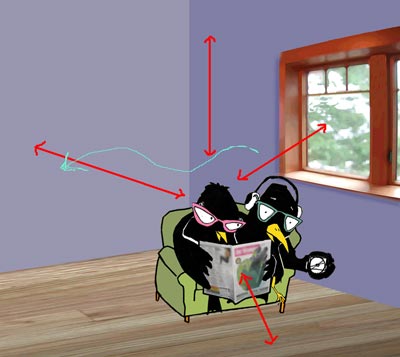Thermal Comfort
Feeling comfortable is determined by more than just what the thermometer says. Humidity, air movement, and mean radiant temperature are also factors, along with the more obvious factors such as your level of activity and amount of clothing you are wearing. Since comfort is subjective, there is no exact determination, but rather a few rules of thumb.

(Note: Real Corvids don't sweat or listen to punk rock, but are subject to the same mechanisms of heat transfer as us humans).
The rule of thumb is that if you set your thermostat to 68 (or so), that you will be comfortable, but anyone who has been outside on a cold, but calm and sunny winter day, knows that air temperature alone does not tell the whole story (in this case, the sun raises the radiant temperature high enough that you don't notice the cold air). Likewise, if it is 90F outside, there is a significant difference in comfort between 20% humidity and 90%--at least if you're standing in the shade--in the sun, the additional radiant heat will make you feel hot either way.
Air temperature: as reported by a thermometer, this is the temperature of the air.
Mean Radiant temperature: While air temperature is a measure of how much cooling (or warming) you get from contact with air, mean radiant temperature is a measure of how much cooling (or warming) you get from the exchange of radiant heat to all the objects in the room.
Warm objects radiate heat toward cold ones, and the mean radiant temperature is the average temperature of all the objects around you. A sunny window, or hot radiator will raise the mean radiant temperature significantly (at least on the side facing the heat), while a cold floor or window will lower the mean radiant temperature. A special radiant thermometer (which is more like a camera that sees infrared) and measure the temperature of room surfaces (you'll have to correct for the emissivity of the material being measured), but even with this device, it is not straightforward to determine mean radiant temperature. Even if you could, people don't respond uniformly to it.
Most people assume that their walls and ceiling are at room temperature, but in fact this is rarely the case, especially in poorly insulated homes, and in all cases windows & doors since even the goods one are relatively poor insulators. For typical 2x4 construction with fiberglass insulation, it would not be usual for the wall temperature to be 10F colder than room temperature. Of course the surface temperature on the inside is also dependent on what the temperature is outside. Increased insulation brings the surface temperature closer to room temperature.
There is some controversy on how to combine air temperature with mean radiant temperature to get a perceived temperature, although combining them 50-50 is a common approach. This means that if the air temperature is 72 and the mean radiant temperature is 64, the perceived temperature would be 68. Likewise if the air temperature is 64 and the mean radiant temperature is 72, the perceived temperature would also be 68. Needless to say, these two conditions won't actually feel the same.
To further complicate matters, humans tend to be very sensitive to the temperature of their feet, so for those people, the mean radiant temperature is not as important as the radiant temperature at their feet. What is certainly true, is that by adding more insulation and putting in better insulated windows, the indoor radiant temperature moves toward the air temperature, and makes the house more comfortable.
Air movement: moving air acts like convection: it can transfer heat very rapidly. Cold moving will cool you faster, while hot moving air (above 100F) can actually heat you faster rather than cool you. Perspiration removes a large quantify of heat, so as long as your perspiration can evaporate, even hot moving air will tend to cool you. Because of this, moving air generally cools you, and so you can tolerate a higher temperature if a fan is blowing air on you.
Leaky houses have an ample supply of fresh air, but they are also uncomfortable due to those cold air currents.
Humidity: humidity increases the heat conduction of air, so cold air will seems colder, and warm air will seem warmer. On the warm side this is especially true if the humidity rises high enough to reduce the effectiveness of perspiration. Because the ideal humidity level for health reasons is between 40 and 60%, humidity should not generally be a factor in comfort.
Leaky houses tend to cause the indoor air to be very dry when it is below freezing out: the colder it is, the drier the house gets. It would not be unusual to find such a house at only 20% relative humidity in the winter. This dry air will tend to make a 70F room feel cooler than one with a moderate amount of humidity.
